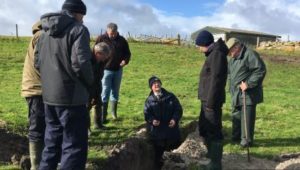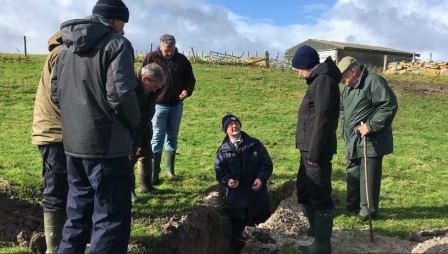Uist Soil & Nutrient Network: 1st meeting – event summary
20 September 2018This was the 1st meeting of the Uist Soil & Nutrient Network Farm so it started with an introduction to the farm and the Soil & Nutrient Network.
This was followed by a presentation on soil analysis, its use and how to interpret the results. Gavin Elrick, SAC consulting then discussed the importance of liming in improving the productivity of croft land. He then went on to discuss the role and requirements of the key nutrients for grassland.
The meeting concluded with a look at soil texture, structure, and drainage out in the field where soil pits had been dug.
The key take-home messages from the event were :
- Soil testing is a crucial step in managing healthy soil. It will provide details of soil pH, and the status of major nutrients. If you don’t measure it, you can’t manage it!
- pH is typically the main limiting factor and should be addressed before any other deficiencies in the soil.
- The majority of crops on Uist are grown on the machair land. The calcareous soil has a very high pH and is usually found to be low in P and K. Fertiliser should be targeted to replace nutrient offtake as the soil tends to leach or lock up over applied nutrients.
- The majority of reseeds carried out during the IDP now require rejuvenation as the pH and nutrient levels have dropped considerably below target in many cases.
- Deep compaction is unlikely to be an issue in Uist, however, surface compaction caused by livestock is potentially an issue. Using an aerator on this will help to boost productive an eliminate compaction, care should be taken however not to aerate soil which isn’t compacted as this has proven to have a detrimental effect on the yield of the following grass crop.
- Adequate drainage is vital in maximising the productivity of croft land. The installation of drainage should, however, be focussed on the better land where gains are more likely to offset the investment required. Drainage can be as simple as cleaning open ditches and maintaining outfalls, to the installation of a full drainage system.
Please use the links below to download information that is relevant to the topics discussed during the event.
- Valuing Your Soils – Practical Guidance for Scottish Farmers
- This brochure includes useful information about Scotland's agricultural soils and practical advice outlining the upfront financial savings and business benefits of better soil management and the efficient use of resources. Action and problem-specific 'field-sheets' are designed for busy farmers with limited time for reading.
- Topics: Soils, Climate Change, Water Management and Crops and Soils
- Visual Evaluation of Soil Structure (VESS) Score Chart
- This is a downloadable copy of the Visual Evaluation of Soil Structure (VESS) score chart for use in-field.
- Topics: Soils
- Technical Note (TN656): Soil Information, Texture & Liming Recommendations
- • Web based access to information on your soils on your farm is described. • Soil texture classes of mineral soils are described and identified by hand texturing. • Liming recommendations for different soils and managements are tabulated.
- Topics: Soils
- Technical Note (TN668): Managing Soil Phosphorus
- Efficient soil P management is challenging due to the varying ability of soils to mediate and regulate plant available forms of P. Farmers and land managers in Scotland are now able to access farm level information about their soils making it possible to provide more accurate P management advice.
- Topics: Crops and Soils
- Farming For A Better Climate: Practical Guide – Alleviating Soil Compaction
- This Practical Guide gives some ideas on how to alleviate soil compaction.
- Topics: Soils
- Farming For A Better Climate: Practical Guide – Improving Soil Quality
- This Practical Guide concentrates on how we can improve soil quality to help us to adapt to climate change.
- Topics: Soils
- Farming For A Better Climate: Practical Guide – Soil Management
- Topics: Soils
- Practical Guide: Soil sampling I – How to take a soil sample
- This practical guide details what is required to take a soil sample for analysis that is representative of the area sampled.
- Topics: Soils, Climate Change and Water Management
- Practical Guide: Soil sampling II – Benefits to your business
- This practical guide details how soil sampling can benefit businesses by increasing productivity and create efficiencies on fertiliser inputs through better nutrient planning.
- Topics: Soils, Climate Change and Water Management
- Practical Guide: Tyre Selection & Management
- This practical guide explains how to reduce soil damage, improve fuel usage and reduce overall green house gas emissions by selecting the correct tyre size, type and pressure.
- Topics: Climate Change
Sign up to the FAS newsletter
Receive updates on news, events and publications from Scotland’s Farm Advisory Service

